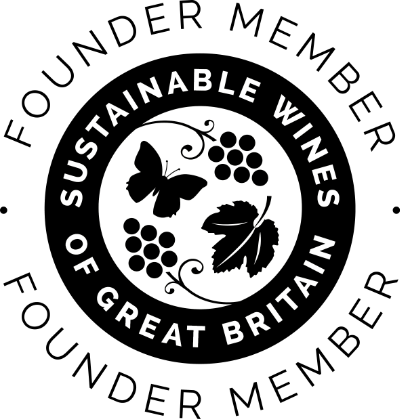Laura Rhys, Master Sommelier, takes us behind the scenes in the winery to explore the art of blending – where the pursuit of consistency is one of winemaking’s most intricate challenges.
Wine is often seen as a product of nature. Wander through the vines, look at the perfectly ripe grapes ready to be picked, and it’s easy to believe that wine is simply the result of soil, sun and time. But when it comes to making traditional-method sparkling wines, the human touch is just as crucial.
Once harvest is over and the wines are safely tucked into their tanks and barrels, the winemaking team turns its attention to blending – a process that marries technical precision with artistry, intuition and experience.
As a Master Sommelier, I have spent years tasting wines from all over the world, at every stage – straight from the tank, aged in barrel, poured from bottle. Tasting wines of all ages, with a multitude of different foods. It’s been an invaluable experience. At Gusbourne, it allows me to bring another perspective to our grading and blending sessions which take place with our knowledgable, skilled winemaking team.
Blending is intricate, intuitive and spellbinding, with sometimes unexpected results from the smallest addition or tweak.
Shaping the vintage
Each year, in the first months, the winemaking team and I lock ourselves away for weeks to taste and grade around 250 individual base wines. Each has its own unique character, structure and style, making it suited to a specific blend.
For me, this is the first real study of the wines from the previous harvest – a moment I always find hugely exciting. It’s our first opportunity to understand last year’s fruit.
We sit down together, laptops open, taking notes at speed. In front of us, rows of base wines wait, each bottle lined up and labelled, ready to be assessed. Even though Mary and the team have been tasting these wines since the grapes were pressed, there’s something special about seeing them all together for the first time – getting the full picture of the vintage.
We taste individually, then discuss our views after each flight. The days are a mix of intense concentration and lively debate. After years of tasting together, we know each other’s palates well, but we all bring our own perspectives – and the discussion is always fascinating.
Only once each base wine has been graded – assessed for its flavour profile, structure, aging potential and suitability for different blends – can the blending itself begin. By combining different base wines, we create finished wines with greater complexity and depth, wines that are more than the sum of their parts.
Blending for balance
English sparkling wine has cemented its place on the world stage as one of the most exciting regions for top-quality traditional-method sparkling wines.
A key reason for this is our cool climate, which produces grapes with bright acidity, delicate fruit and subtle nuance. These are wines that lend themselves to blending, where layers of complexity and elegance can be carefully built.
Ask Mary Bridges, our Head Winemaker, about her approach to blending and she’ll talk passionately about balancing consistency with the unique character of each vintage.
And it’s true. We use the blending process to create complex, elegant wines that reflect a particular time and place. Every vineyard, every block within it, has its own story to tell. Since we only make single vintage wines, blending is crucial. It allows us to capture the essence of each harvest while maintaining the style and signature of our cuvées.
Instead of blending across vintages, we blend across different sites, clones, soils, grape varieties, fermentation vessels and winemaking techniques. It’s a process that creates a true mosaic of blending components, each bringing its own aromas, textures and structures.
With vineyards in both Kent and Sussex, we see distinct differences in the wines they produce. Kent tends to bring weight, richness and roundness; Sussex gives freshness and linear acidity. But even within a single vineyard, different blocks – sometimes planted with different clones of the same grape – can produce strikingly different wines. Multiply that variation across all our vineyard plots and it’s easy to see how we end up with hundreds of different blending components each year.
I’m always amazed at how six wines in a single flight, all made from the same grape variety and sometimes grown just a few hundred metres apart, can taste so dramatically different.
Highlighting the details
The key to great blending is not just about finding balance – it’s about highlighting what makes each base wine special and showcasing it to its fullest potential.
It could be a precise, mineral-driven Chardonnay that’s destined for Blanc de Blancs, or an intense, brooding Pinot Noir that brings structure to a blend.
Once grading is complete, the real work begins. The winemaking team spends weeks tweaking and refining, adding a little here, shaving a little off there. The goal is to create a wine that achieves perfect balance - between fruit character, structure and style. A wine that will age gracefully and only reveal its full self after years of patience.
Each of the three grape varieties we grow has its own distinct personality. Chardonnay brings citrus and orchard fruit, a structured acidity and a mineral precision that makes it the backbone of many blends. Pinot Noir adds weight, body and roundness, with red fruit, red apple and sometimes darker, spicier tones. Meunier, softer and more supple, contributes delicate fruit character and floral notes.
Blending isn’t just about combining different grapes, as in our Brut Reserve, where Chardonnay’s elegance meets the rounder, fuller notes of Pinot Noir and Meunier. Even in single-varietal wines like Blanc de Blancs, blending is vital. It allows us to select Chardonnay base wines that express poise, elegance and finesse while layering in complexity from different parcels and fermentation styles. Some of our wines have as many as 60 different blending components.
When we blend, we think not just about how the wine tastes today but how it will evolve over years – sometimes decades – of lees aging and bottle maturation. We’re looking into the future, predicting how these wines will knit together, develop and reveal their full potential.
The final composition
Blending is a craft that exists at the intersection of science, nature and intuition. It is the point where structure meets artistry – where precision meets unpredictability.
With each new vintage, we create wines that reflect a particular moment in time, wines that tell a story of the season that shaped them.
And that’s the magic of blending. It transforms individual components into something greater, crafting wines that will be poured, shared and celebrated for years to come.
You'll find a selection of our award-winning vintage-only blends - available with free UK delivery - here.








